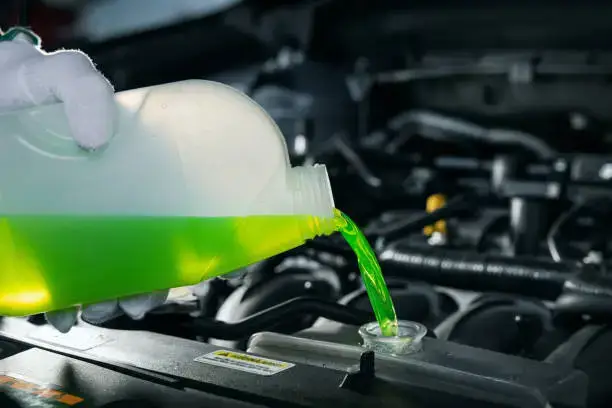Your car’s cooling system depends on antifreeze — also known as engine coolant — to keep the engine operating safely in all weather conditions. Without it, the engine could overheat, corrode, or even freeze in cold temperatures.
Knowing what antifreeze is and how it works helps you maintain engine health, prevent breakdowns, and extend the lifespan of critical engine parts like the radiator, water pump, and thermostat.
What Is Antifreeze?
Antifreeze is a specially formulated liquid that regulates your engine’s temperature. It’s made from ethylene glycol or propylene glycol, mixed with additives that prevent rust and scale buildup inside the cooling system.
When combined with water (typically a 50/50 mix), antifreeze becomes coolant — the fluid that circulates through your car radiator, engine block, and heater core.
Main Functions of Antifreeze
- Prevents overheating: Raises the boiling point of coolant.
- Prevents freezing: Lowers the freezing point during cold weather.
- Prevents corrosion: Protects metal parts like the cylinder head, radiator, and water pump.
- Lubricates seals and gaskets: Extends the life of rubber and plastic components.
How Does Antifreeze Work?
Antifreeze works as part of a closed-loop cooling system that continuously circulates through the engine while driving.
- The water pump pushes coolant through the engine block.
- As coolant absorbs heat, it travels to the radiator.
- Airflow from the fan belt and grille cools the fluid.
- The thermostat opens and closes to regulate flow and maintain optimal temperature.
- The cooled fluid then cycles back to absorb more heat.
This continuous circulation prevents the engine from reaching damaging temperatures — especially important in South Africa’s hot climate.
Common Symptoms or Signs of Antifreeze Problems
Over time, antifreeze can degrade, become contaminated, or leak from the system. If that happens, you may notice:
- Engine overheating: A high temperature gauge or dashboard warning light.
- Sweet smell from the engine bay: A sign of coolant leakage.
- Low coolant level: Repeatedly topping up means there’s a leak.
- Rusty or brown coolant: Corrosion or contamination inside the radiator.
- White smoke or steam: Possible coolant entering the combustion chamber.
- No cabin heat: Air pockets or low coolant levels affecting circulation.
Ignoring these symptoms can lead to head gasket failure, radiator leaks, or engine damage.
How to Check or Replace Antifreeze
Regular inspection and replacement of antifreeze are essential for efficient cooling. Here’s how to do it safely:
1. Check Coolant Level
- Ensure the engine is cool.
- Locate the coolant reservoir and inspect the level between the “MIN” and “MAX” lines.
- If low, top up with the recommended antifreeze mixture (check your vehicle manual).
2. Inspect Coolant Condition
- Look at the coolant color — it should be bright green, orange, or pink depending on the type.
- Brown or cloudy fluid indicates contamination and the need for a radiator flush.
3. Flush and Refill the Radiator
- Drain old coolant from the radiator drain plug.
- Use a radiator flush solution to remove rust and residue.
- Refill with a 50/50 mix of distilled water and quality antifreeze.
- Run the engine with the heater on to remove trapped air, then top up as needed.
Perform this service every two years or 40,000–60,000 km for optimal protection.
Antifreeze Types and Compatibility
Using the correct antifreeze type is critical for preventing corrosion and maintaining system performance.
| Type | Colour | Recommended Use |
|---|---|---|
| IAT (Inorganic Acid Technology) | Green | Older cars; replace every 2 years |
| OAT (Organic Acid Technology) | Orange/Red | Modern cars; long-life protection |
| HOAT (Hybrid Organic Acid Technology) | Yellow/Blue | Mix of both; used in many European vehicles |
Tip: Never mix different antifreeze types — it can form sludge that blocks coolant passages.
Antifreeze Price in South Africa
Costs vary depending on vehicle type and brand, but here’s a general guide:
- 1L concentrate: R80 – R150
- 5L ready-mix coolant: R180 – R350
- Long-life antifreeze: R250 – R500
- Radiator flush service: R600 – R1,200
Buy trusted brands like Castrol, Liqui Moly, or Motul from car-parts.co.za, auto spares near me, or your local Cape Town auto parts store.
Related Car Parts and Maintenance Tips
While maintaining your antifreeze system, check related parts such as:
- Car radiator: Essential for cooling efficiency.
- Thermostat: Controls coolant flow.
- Water pump: Keeps fluid circulating.
- Radiator cap and hoses: Prevent leaks and pressure loss.
- Oil cooler and gaskets: Protect against internal leaks.
Helpful guides:
Conclusion: Why Antifreeze Maintenance Matters
Antifreeze protects your engine from extreme temperatures, corrosion, and damage. Ignoring coolant maintenance can lead to overheating, engine wear, and expensive repairs.
Check your coolant regularly and replace it as recommended to keep your car performing smoothly — whether you’re driving in Durban heat or Cape Town winter.
Need quality antifreeze or cooling parts?
Find affordable, genuine products at car-parts.co.za today.

